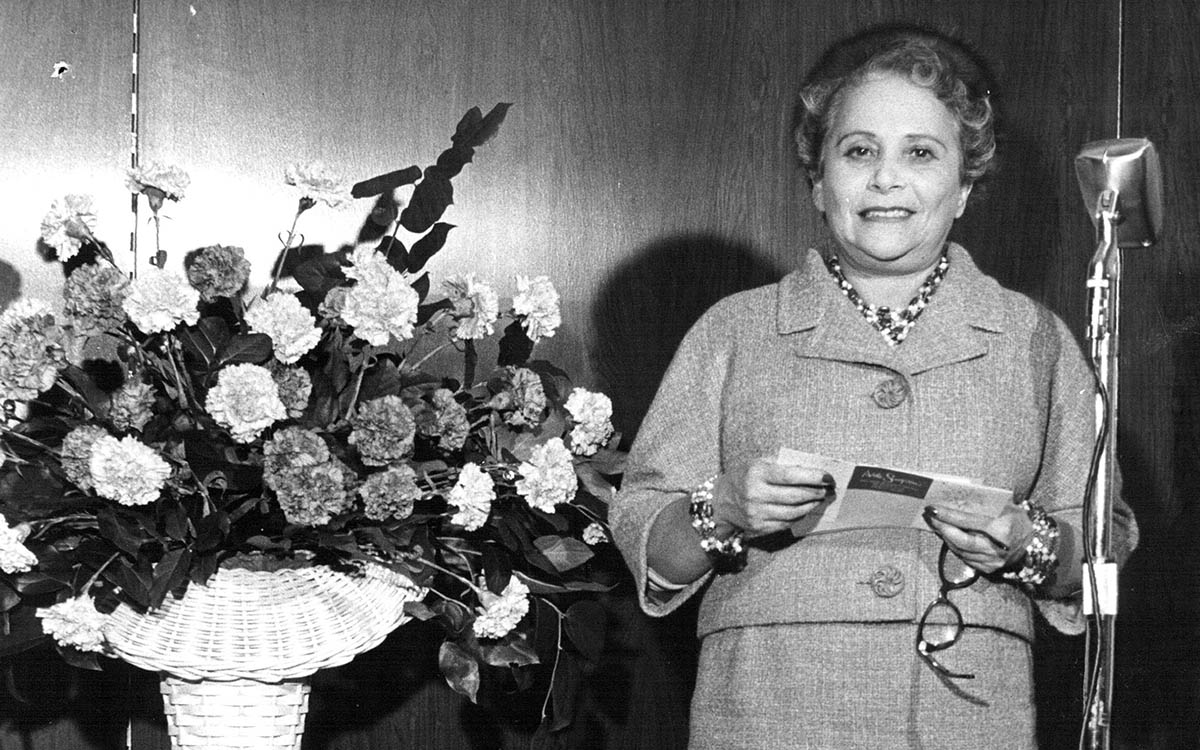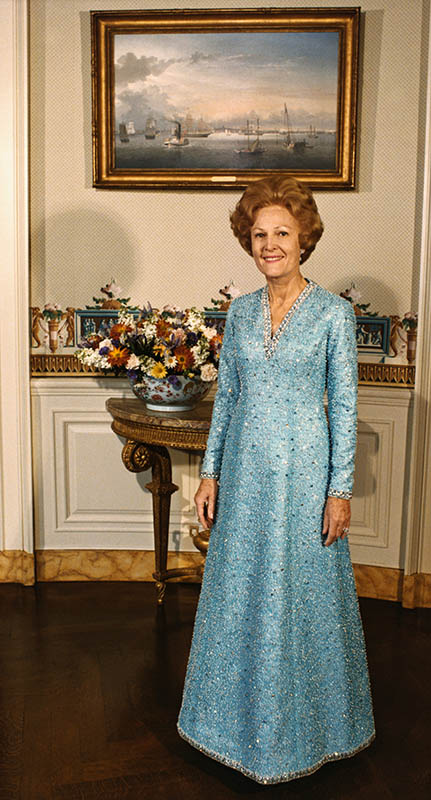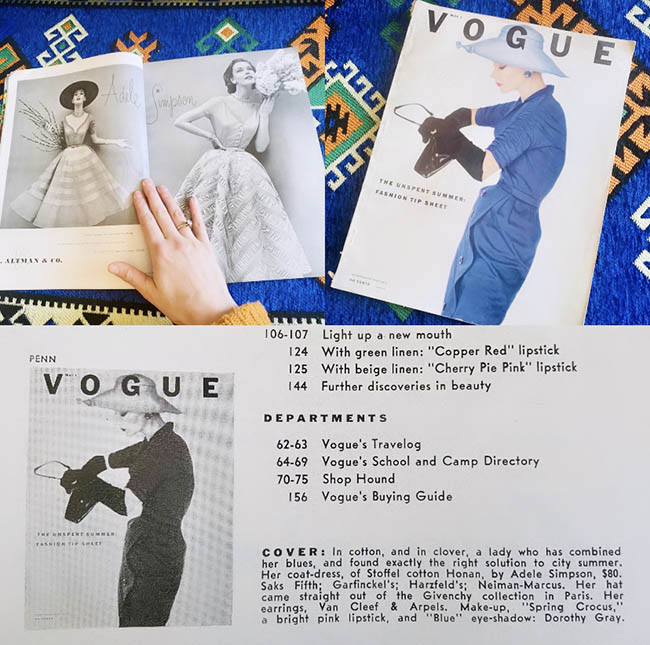Women of History: Adele Simpson

Adele Simpson in Denver, 1959. © Denver Post / Contributor / Denver Post / Getty Images.
Listen to this article
A Bible passage from the book of Job always fascinated post-war fashion designer Adele Simpson: “Deck thyself now with majesty and excellency; and array thyself with glory and beauty” (40:10). She believed that men and women should use garments to express their highest selves—a viewpoint informed by her spiritual beliefs.
This four-foot, nine-inch fashionista (she had to stand on a soapbox during fashion shows to be seen) attributed her achievements as an artist and businesswoman to the study of Christian Science. And she expressed gratitude to Mary Baker Eddy for providing teachings that led to greater happiness and harmony in her career and marriage.1
Simpson created innovative and accessible fashions that hit global runways and even graced the covers of Vogue magazine. One of the founders of the Council of Fashion Designers of America (CFDA) and the Fashion Group International (FGI), she is also known as “America’s First Ladies’ Designer.” Over the course of four decades she dressed Mamie Eisenhower, Lady Bird Johnson, Pat Nixon, Betty Ford, Rosalyn Carter, and Barbara Bush.2
She was born Adele Smithline on December 28, 1903, in New York City’s Upper East Side, to Latvian parents Jacob Smithline (c.1870–1936) and Ella Bloch (c.1870–1928). The couple immigrated to the United States from Latvia in 1901. Her mother worked as a homemaker and her father was a tailor. In keeping with the family’s work with textiles, she and her four sisters were all given private embroidery lessons at home, and their parents hired a dressmaker—something common for larger middle- and upper-class families in those days. An entire wardrobe was fashioned for the children. And as the youngest, Adele received mostly hand-me-downs. This motivated her to start making her own clothes. By the age of 14, she was handcrafting ensembles for herself and providing wardrobes for all her siblings.3
Even at a young age, Adele was motivated to look at cultures around the world for design inspiration. At one point she sewed a collection of pieces for one sister to wear on a trip abroad, which was based on Egyptian patterns and embroidery.4 This, she explained, set her career in motion:
One of my sisters, a gifted artist, had a job as a sketcher with Ben Gershel & Company, a clothing manufacturer. Her employer, admiring what she wore, wanted to know where she got her clothes. When she told him that her little sister made them, he sent for me and gave me a job.5
At this time Adele was still a teenager, attending school. But just a few years later, at the age of 21, she would rise to the top of Seventh Avenue, to be then known as one of the highest paid designers in the industry.6
Throughout her 20s Adele explored various creative opportunities in her design career. She began classes at New York’s Pratt Institute, and soon had a job with the noted fashion designer Bill Blass. Later she worked for designer Al Lasher, became a partner in the firm, acquired it at age 29, and became its director, renaming the brand Adele Simpson.7 She was blazing a trail for women in the male-dominated design industry. But her pioneering work was that of a lifetime—over 25 years later, The New York Times was reporting stories like this:
Fashion is a woman’s business. But the vast majority of fashion houses are run by men. There are, however, a few notable exceptions, the outstanding of which is Adele Simpson, Inc. It should be noted, of course, that many women’s apparel houses carry the names of women, but more often than not, these names designate the founder or the designer rather than the principal owners.8

First Lady Pat Nixon’s inaugural ball gown, designed by Adele Simpson, was a princess gown in turquoise blue silk organza over turquoise and silver silk lamé. January 17, 1973. © Bettmann / Contributor / Bettmann / Getty Images.
In 1930 Adele married Wesley Simpson, a fabric salesman. The couple first met at her office when Wesley showed her a new line of materials. Soon after that, mutual friends provided them with a more formal introduction. And in the process, she was also introduced to Christian Science, through Wesley’s sister, Elsie.9 Reflecting on this, Adele recalled what attracted her to the religion:
From the time I was a small child, I instinctively resisted the concept of God to be feared. At the same time, I didn’t know how to go about finding a better understanding of Him. So as I grew up, while I honored God and the Ten Commandments, I was not pursuing religion. I was in pursuit of a career that would establish fashion trends and lead me to the top in my field. This had resulted in a frantic pace of activity difficult to maintain, creating tensions at home and business. At this point, I learned about Christian Science and began to know God as the universal Principle, Love.10
Adele and Wesley worked closely, at one point opening their own dress manufacturing company. Balancing the personal and professional sides of their relationship was trying at times, and in these moments she found herself turning to prayer. Her sister-in-law had discussed with her “the healing, calming power of Love.”11 This led her to begin studying Christian Science. She was quite moved by “Marriage,” the third chapter in Eddy’s book Science and Health with Key to the Scriptures, in which she found helpful guidance for enriching her own marriage. She was especially fond of this passage:
[Christian] Science inevitably lifts one’s being higher in the scale of harmony and happiness. Kindred tastes, motives, and aspirations are necessary to the formation of a happy and permanent companionship.12
Soon Wesley began his own study of Christian Science. Because the two of them were united in activities both inside and outside of the home, Adele found the harmonizing effects of practicing their new faith particularly helpful. She also found Christian Science bringing the balance to her life that had been lacking.13
In her work Adele was particularly interested in mastering leadership skills, especially valuable at a time when women did not typically direct businesses. She turned for an example to what the Bible says about Moses leading his nation out of Egypt. In Science and Health she found what she called “…a fundamental Science of Life—of man and the universe—with rules and laws which, if applied, would bring achievement and spiritual satisfactions to men and women.” And she “decided that to the best of my ability, I would apply these scientific, sacred laws of God to my own career.” She closely studied the weekly Lesson-Sermon each morning in the Christian Science Quarterly and found that this brought inspiration in overseeing the artistic work of others:
Dealing with 60 to 70 people a day in my manufacturing organization, I have found that the harmonizing factor in human relationships is divine Love. If I arrive in the morning to find an employee doing something wrong, I don’t confront him before his co-workers, but wait for the right opportunity, usually at the end of the day. Then I explain what was not right, ask him to think about it overnight and see how it can be corrected. This practice has won for me many loyal and thoughtful workers.
In the garment manufacturing business, with its temperaments and pressures of seasonal deadlines, people tend to be excitable. The teachings of my religion that all is under the government of divine Love has not only helped me remain calm under stress, but also helped bring an atmosphere of calmness to others.14
As an artist, Adele attributed much of her process to a passage in Science and Health that is part of an answer to the question “What is man?”: “…that which has not a single quality underived from Deity; that which possesses no life, intelligence, nor creative power of his own, but reflects spiritually all that belongs to his Maker”15 She even called this “a governing rule in my creative work.” She came to remind herself daily that God came first in her life, and that God governs man and the universe. Eddy’s teaching that man is not a personal creator relieved her of tensions and egotistical beliefs. She saw that her work as an artist “was to image forth the ideas that came from God, the one creative Mind.”16

Images in Vogue magazine, May 1, 1952, featuring a cover photo of a blue Adele Simpson cotton coat-dress, a description of the cover, and an interior advertisement.
As her career blossomed, Adele created beautiful, chic designs that were also practical for women. The New York Times explained:
Mrs. Simpson took French couture and gave it an American ready-to-wear interpretation. Her color-coordinated dresses and jackets and well-cut coats in fine fabrics found favor among well-heeled women of her time in search of classic clothes that did not cost a month’s rent.”17
She is credited for repopularizing dresses that women did not need to pull over their heads, which was an uncommon feature in the previous decades. And also for the reversible jacket. She was determined to make clothes for women that simplified dressing.18 While the majority of leading designers were men, Adele effectively employed a firsthand understanding of women’s bodies and their day-to-day lives in creating comfortable yet sophisticated clothing. The Fashion Institute of Design & Merchandising commented that she “was a pioneer in her own quiet way,” adding that “she introduced cotton and sari fabric for eveningwear, adding an unconventional twist to her conservative silhouettes. And she often used black in her spring and summer looks ….”19
In 1961 Adele traveled to Peru where, according to The Christian Science Monitor, she absorbed “colors and culture, arts and crafts, the unchanging old and the stirring of the new” to inspire her 1962 summer collection. She used Pecora embroidery in many of her collection pieces and also incorporated Peruvian Tapada shawls and traditional ponchos in the designs for tailored and party dresses.20
Adele traveled to many countries to hold fashion shows, including France, Turkey, China, and India. And these trips offered further opportunities for turning to her faith:
… I go into a country not as a stranger, but as a friend. Through the eyes of my new friends, I see a country from within …. My religious teaching that there is one universal Father-Mother, and therefore one family of man, has led me to share with several countries abroad my knowledge of manufacturing techniques and fashion trends—helping them in their efforts to produce for a world market ….21
On September 8, 1975, Wesley passed away. They had been married nearly 45 years.22 She continued to run her firm for nearly another decade, before turning her business over to her daughter and son-in-law, Joan and Richard Raines, in 1984. By then the couple had worked for her company for 30 years. “My mom was very much her mother’s daughter,” said their son, Roger Raines. “She had a real spark and was always entertaining.” Joan primarily designed daytime dresses, suits, coats with matching skirts, evening boots, and raincoats. In 1991 Adele Simpson Inc. and Baron Peters, Inc. merged to form ASBP. The following year, Joan and Richard resigned from their positions. Soon after, their business partner Baron Peters filed for bankruptcy.23
Adele passed away on August 23, 1995, at her home in Greenwich, Connecticut. She was 91. She was survived by her two children, Joan Raines and Jeffery Simpson, along with three grandsons, and great-grandchildren. By this time Joan had taken over their fashion house. She remembered this about her mother:
She had a great philosophy that she taught her children, which was, “Never take no for an answer.” She was a real pioneer and a real trouper. She wasn’t afraid to gamble when it came to buying piece goods or cutting goods for stock. She often said, “If you put your hand in hot water, take it out.”24
Adele Simpson dedicated her life to the business of fashion—but to her, it meant so much more than just clothing. It was “a fascination with the way people all over the world express their sense of beauty.” Her commitment to Christian Science permeated her life and reached around the world, as indicated in these reflective words:
Everywhere I travel, I seek out Christian Science branch churches and attend the Sunday services and Wednesday evening meetings. I never cease to be impressed by the fact that all over the world—whether in Italy, France, South America, Germany, England, the Far East, the Near East, Beverly Hills, Dallas, New York, Greenwich, Boston—the Christian Science services are the same. Whether conducted in English, French, Italian, Spanish, German—I am grateful to Mary Baker Eddy for her provision for a worldwide church. 25
For further reading, please see other articles on the Library’s website, including “Women of History: Martha Matilda Harper.”
- Marcy Babbitt, Living Christian Science: Fourteen Lives (Englewood Cliffs, New Jersey: Prentice-Hall, Inc., 1975), 190.
- “Adele Simpson: Fashion Designer for First Ladies,” Los Angeles Times, 26 August 1995, https://www.latimes.com/archives/la-xpm-1995-08-26-mn-39154-story.html; “Woman’s Dress, 1948-58,” National Museum of American History, https://americanhistory.si.edu/collections/search/object/nmah_360605.
- Babbitt, Living Christian Science, 188.
- Adele Simpson, interview by Phyllis Feldkamp, 13 June 1978, FIT Special Collections & College Archives, https://www.youtube.com/watch?v=FGn-5UiLTQ4, 16:45–17:30.
- Babbitt, Living Christian Science, 188.
- “Adele Simpson: Fashion Designer for First Ladies,” Los Angeles Times, 26 August 1995, https://www.latimes.com/archives/la-xpm-1995-08-26-mn-39154-story.html;
- Babbitt, Living Christian Science, 191–192.
- Herbert Koshetz, “Fashion House Run by a Woman Is a Rarity,” The New York Times, 21 December 1959, 39.
- Babbitt, Living Christian Science, 189. “Wesley Simpson, Designer And Textile Executive, 72,” The New York Times, 9 September 1975, 42.
- Babbitt, Living Christian Science, 187.
- Babbitt, 190.
- Mary Baker Eddy, Science and Health with Key to the Scriptures (Boston: The Christian Science Board of Directors), 60.
- Babbitt, 190.
- Babbitt, 190, 196.
- Eddy, Science and Health, 475.
- Babbitt, 191.
- Constance C.R. White, “Adele Simpson, 91, a Designer And Postwar Fashion Leader,” The New York Times, 24 August 1995, D21.
- Babbitt, 188.
- “Spotted: Elegance in Black and White,” https://fidmmuseum.org/2015/05/adele-simpson.html#:~:text=spotted
- Marilyn Hoffman, “Peru Now Inspires Fashion,” The Christian Science Monitor, 21 May 1962, 4.
- Babbitt, 193.
- “Wesley Simpson, Designer And Textile Executive, 72,” The New York Times, 9 September 1975, 42.
- Lisa Lockwood, Joan Simpson Raines and Richard Raines obituary, Women’s Wear Daily, 20 May 2020.
- Adele Simpson dead at 91,” Women’s Wear Daily, August 1995, 6.
- Babbitt, 200.

